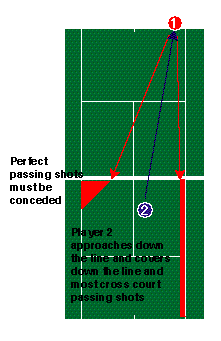|
TennisOne Lessons
 Critical Look at Stow Forehand

Tom Stow and the"All Court Forcing Game"
Part 5:
by Jim McLennan, Senior Editor, TennisONE
Go to: Part 1 | Part 2 | Part 3 | Part 4 |
A Critical Look at the Tom Stow Forehand
In my small tennis circle I am known to move fairly well and to own a versatile backhand, and sadly, little else. So at the outset I must apologize for the following discussion of the Stow forehand, for those that know me are now chuckling that I have quite the nerve to dissect something that I never truly mastered.
For Stow, everything was a matter of balance, precise shift of weight against the ball, the most solid collision, and a racquet that swung not quickly but rather heavily. To that end, the forehand preparation put the weight balanced over the ball of the back foot, and the left shoulder tilted slightly below the right shoulder at this moment of the backswing . From this pose, we were (and still are) prepared to come against the ball, and meet the ball well in front. Interestingly, placing the right shoulder slightly above the left, caused a slight downward swinging action, more in line with the flat conk or a subtle topspin action . This preparatory position is in sharp contrast with the modern forehand, where the racquet swings not heavily, but extremely fast . And with this incredible racquet speed, greater and greater amounts of topspin are now evident to control the ball.
 The modern forehand diverges from Stow in one other equally important distinction, and that is the placement and role of the left elbow. With Stow, the weight shift, coming against the ball, was paramount. To that end, the collision rather than the speed of the swinging racquet was emphasized. The books that picture Stow, always indicate somewhat of a "silent" left arm during the hitting action, that is the arm was held more or less against the player's side, and provided balance. In the modern game, as you can see with this picture of Michael Chang's forehand, the left arm comes well back with the racquet, and then precedes the racquet on its forward swing into the ball . Sampras, Agassi and all the others make contact with the left elbow well up and away from the body, and indeed this creates a very long swinging lever, which adds speed to the racquet head. The modern forehand diverges from Stow in one other equally important distinction, and that is the placement and role of the left elbow. With Stow, the weight shift, coming against the ball, was paramount. To that end, the collision rather than the speed of the swinging racquet was emphasized. The books that picture Stow, always indicate somewhat of a "silent" left arm during the hitting action, that is the arm was held more or less against the player's side, and provided balance. In the modern game, as you can see with this picture of Michael Chang's forehand, the left arm comes well back with the racquet, and then precedes the racquet on its forward swing into the ball . Sampras, Agassi and all the others make contact with the left elbow well up and away from the body, and indeed this creates a very long swinging lever, which adds speed to the racquet head.
To more fully understand the role of the left elbow, see the mechanics of throwing in the TennisONE library. But in a nutshell, one measures the length of the lever arm from its point of rotation. So if the body and shoulder are held still, and one only swings from the elbow, the lever arm is measured from the elbow to the sweet spot of the racquet, approximately 36." If the arm swings from the right shoulder, as in the Stow model, the lever arm is now approximately "45." When the arm swings from the left shoulder by opening up more into the hit, now the arm is perhaps "60." And when as the professionals the hub about which the arm rotates is the left elbow, one can get nearly a "75" lever arm, which is exactly how the Agassi forehand looks.
When the racquet has this much potential acceleration, topspin will be nearly imperative, and an aid in topspin is to place the right shoulder lower than the left on the backswing to more swing up against the ball. This is the significant divergence from the Stow forehand, for in the Stow forehand the stroke was much more flat and the swing far slower. But in the modern game many of the players obviously dip the right shoulder low as they prepare to whip the racquet into the ball.
It's my opinion that the Stow forehand, a flat, simpler stroke, will return to the professional game. This type of simplicity would have its best use on the return of serve, where the opponent has generated all the pac, and the returner wants maximum control. I would hazard the guess that one of the next champions will have extremely simple strokes, almost like a Miroslav Mecir, but with a dominating serve and cat quick footwork (similar to Stefan Edberg).
|
|
